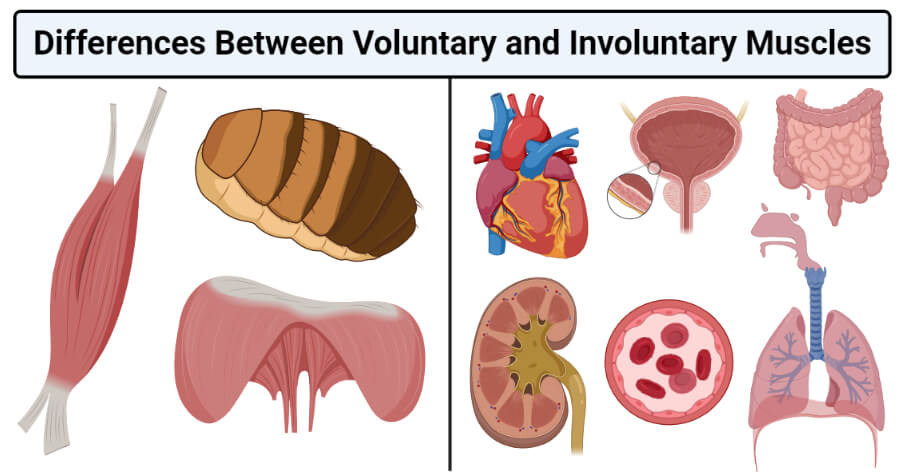
Exploring the Intricate Contrast: Voluntary vs. Involuntary Muscles
Muscles, the workhorses of the human body, are responsible for movement, stability, and various physiological functions. These muscles are broadly categorized into two types: voluntary and involuntary muscles. This distinction is rooted in their control mechanisms, functions, and locations within the body. In this comprehensive article, we will dive into the world of muscles, shedding light on the profound differences between voluntary and involuntary muscles.
Anatomy and Function of Muscles
Before delving into the specifics of voluntary and involuntary muscles, let’s first understand the basics of muscle anatomy and function.
Muscle Anatomy
Muscles are made up of bundles of long, cylindrical cells called muscle fibers. These fibers contain specialized contractile proteins, primarily actin and myosin, which allow muscles to contract and generate force. Muscles are connected to bones via tendons, and when they contract, they pull on the bones, enabling movement.
Muscle Function
Muscles serve a multitude of functions in the body:
- Movement: Muscles facilitate voluntary and involuntary movements of the body, including walking, running, blinking, and pumping blood.
- Posture and Stability: Muscles provide the structural support necessary to maintain posture and balance while standing or sitting.
- Heat Generation: Muscle contractions generate heat, helping to regulate body temperature.
- Protection: Some muscles, like the abdominal muscles, protect internal organs.
- Digestion: Involuntary muscles in the digestive tract aid in the movement and breakdown of food.
Voluntary Muscles
Voluntary muscles, also known as skeletal muscles or striated muscles, are under conscious control. They are attached to bones and are responsible for voluntary movements such as walking, talking, and writing. Key characteristics of voluntary muscles include:
1. Conscious Control
Voluntary muscles are subject to conscious control by the individual. When you decide to move a specific part of your body, signals from the brain travel through the nervous system to activate the relevant voluntary muscles.
2. Striated Appearance
Under a microscope, voluntary muscles appear striated or striped due to the organized arrangement of actin and myosin filaments. This striation is responsible for the muscle’s strong and precise contractions.
3. Attachment to Skeleton
Voluntary muscles are attached to the skeleton by tendons. When these muscles contract, they cause bones to move, resulting in joint motion and, ultimately, voluntary actions.
4. Fatigue
Voluntary muscles can fatigue relatively quickly during intense or prolonged activity. This is because they rely on conscious effort and often require more energy.
Involuntary Muscles
Involuntary muscles, also called smooth muscles or non-striated muscles, operate without conscious control. They are found in various organs and tissues throughout the body, performing essential functions such as maintaining organ tone and facilitating the movement of substances. Key characteristics of involuntary muscles include:
1. Unconscious Control
Involuntary muscles function without conscious input. The nervous system and various hormones regulate their contractions based on the body’s needs.
2. Non-Striated Appearance
Unlike voluntary muscles, involuntary muscles lack the striated appearance. This is because their actin and myosin filaments are not as highly organized.
3. Location and Function
Involuntary muscles are found in the walls of various organs, including the digestive tract, blood vessels, and respiratory passages. They are responsible for involuntary bodily processes such as peristalsis (the movement of food through the digestive system), regulating blood pressure, and controlling the diameter of airways.
4. Slow Fatigue
Involuntary muscles are more resistant to fatigue compared to voluntary muscles. This endurance is essential for their continuous, involuntary functions.
Conclusion
In summary, voluntary and involuntary muscles are two distinct categories of muscles in the human body. Voluntary muscles are consciously controlled, have a striated appearance, are attached to the skeleton, and can fatigue relatively quickly during intense activity. In contrast, involuntary muscles operate without conscious control, lack striation, are located in various organs, and are less prone to fatigue.
This differentiation in muscle types reflects the remarkable complexity of the human body, where each muscle type has evolved to fulfill specific functions critical for our survival and well-being. Understanding the differences between these muscle types enhances our appreciation of the intricate interplay of voluntary and involuntary muscles that enable us to live, move, and thrive.



